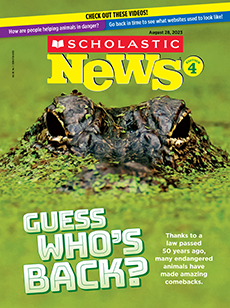Scholastic News: Many people ran from the World Trade Center after it was attacked. You ran toward the disaster. Why?
Clarence Singleton: I had been fighting fires for 22 years. It's a part of me. I knew that people would be in need of help, and they were suffering. I wanted to get over there as soon as possible and do what I could do.
SN: What did you see when you arrived at the scene?
CS: It looked very gloomy. There was just a haze of dust throughout the area. It was like a ghost town, just a lot of debris on the ground—a lady’s purse, shoes, office supplies.
But it didn’t dawn on me that one of the towers had collapsed. I just never expected them to collapse. I'd fought fires in high-rise buildings for 15 or 16 years. We’d just go up, knock the fire down, and go back to the firehouse. My mind just wouldn’t allow me to grasp everything.
I passed firefighters and police officers. They were leaving an area covered with dust. My inner voice told me, “Clarence, stay here and work with these guys.”
SN: What happened next?
CS: We heard this loud, loud bang. We knew that the [second] tower was collapsing. It was just out of instinct, we ran. We bolted.
I ran about 30 feet or so before I found myself on the ground, skidding along. I knew that I was in the collapse area. I was on my hands and knees, and I was just braced. I was hunched up. I was waiting for a big piece of metal to hit me, because I could hear the tower behind me collapsing, one floor pancaking into the next, and picking up momentum.
Then the dust cloud came over, and every breath was suffocating. I could hardly breathe.
The next thing I knew, I saw three or four EMS workers covered with dust, their handkerchiefs around their faces. They helped me to the ambulance. On the way to the ambulance, it was still so dark from the dust that they had to shine their flashlights up at the street corner sign to see where we were.
SN: How did you survive?
CS: I was blessed. It’s a good thing that I fell where I did. That’s probably what saved my life, because debris fell farther out. I fell in a safe spot.
Singleton dislocated his shoulder when he fell. He was in severe pain. Because the hospital was so busy that day, a doctor had to snap Singleton’s shoulder back into place quickly, without anything to numb the pain.
SN: Then what did you do?
CS: I went back down to the scene—just to see what I could do.
